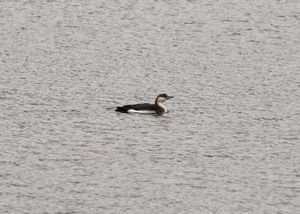Advertisement
Published: January 9th 2008

 Arctic Loon
Arctic Loon
The Arctic Loon that strayed from its Eurasian wintering grounds to spend some quality time in Brownsmead, OR. Those flashy white flanks are the diagnostic identifiers for this bird.Believe it or not, birding can be a sport. As an activity where there are winners and there are losers and there are stats, birding is indeed a sport. Allow me to elaborate:
In the world of birds, there occurs a phenomenon where, on occasion, a particular bird will have some wires crossed (just as humans do), and they get a little lost in life. Instead of returning to their wintering grounds or sticking with their conspecifics en route to their breeding grounds, they find themselves on vacation hundreds of miles from where they belong. On occasion, birdwatchers run across these "vagrants," as they're called, and report to fellow birders of their serendipitous find. When it comes to rarities, word travels fast throughout the birding community, as it means "tickers," or "listers," have the opportunity to add a rare bird to their lifelist (or any list that the bird may not be on, including regional lists such as country, state, or even county lists, other lists such as "year lists," or any combination thereof). Chasing these rare birds is known as, well, "chasing." Sometimes a chase ends happily in seeing the desired bird - winner. Other times a birder will

 Taking Flight
Taking Flight
A male Northern Pintail explodes from the water over its female counterpart."dip," and miss observing the bird - loser.
So, as long as I'm stuck in the States, waiting for an opportunity to delve into the African bush, I decided to do a little chasing today (something I've not done for quite a while). My options were between a Northern Hawk-Owl and Black-headed Gull in eastern Washington, or an Arctic Loon in Brownsmead, Oregon. I opted for heading south and trying to find the bird on vacation from Siberia (I wouldn't want to be there this time of year, either): The Arctic Loon (
Gavia arctica), better known in Eurasia (from where it likely came) as the Black-throated Diver. Not only is this bird much rarer in North America than the other two, but it would also be a life bird (ie. as a bird I've never seen before, a successful chase would add it to my lifelist).
It was a long trip from Seattle, and after three hours of driving I found myself in Brownsmead, looking down Blind Slough for a bird that most of you would probably call a "funny-looking duck." With the help of some local birders (from Tillamook, OR), we found the bird in all its

 Northern Shovelers
Northern Shovelers
A male and two female Northern Shovelers feeding in the flooded fields near Blind Slough.grey-hued glory. It was actually a rather impressive showing - great looks through bins and scope of the bird no more than 60-70 yards away in calm water and good light. Good for viewing, not ideal for taking pictures, though I did manage to get a couple that were decent enough to show the diagnostic characteristics. For the few of you reading this that know birds, you can easily tell it's an Arctic Loon; for those of you non-birders, more or less the only reason I know that this is an Arctic Loon and not the local and much more common Pacific Loon is the presence of those flashy white flanks. Exciting, no? Call me crazy, but I think it is . . .
Advertisement
Tot: 0.184s; Tpl: 0.01s; cc: 19; qc: 102; dbt: 0.1065s; 1; m:domysql w:travelblog (10.17.0.13); sld: 1;
; mem: 1.3mb

 Arctic Loon
Arctic Loon
 Taking Flight
Taking Flight
 Northern Shovelers
Northern Shovelers


